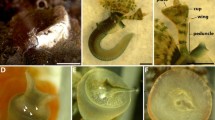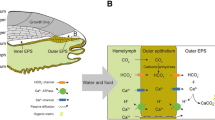Abstract
The effect of tetracycline HCl on synthesis of calcium sulphate statoliths inAurelia is reported. Tetracycline inhibits synthesis of statoliths and nematocysts when administered at an early stage of strobilation. The tetracycline, however, is not incorporated into the developing statoliths or nematocysts. As the tetracycline does not combine with the calcium of the calcium sulfate dihydrate statoliths ofAurelia, an explanation for its inhibitory effects on statoliths and nematocyst differentiation apparently does not rest with an incorporation-related factor.
In vitro studies of four inorganic calcium systems and tetracycline revealed that calcium sulfate dihydrate (gypsum) did not incorporate tetracycline nor did its isostructural equivalent, calcium hydrogen phosphate dihydrate (brushite). Calcium carbonate and calcium phosphate (apatite) did incorporate tetracycline. The explanation for these different behaviors of calcium can be found in the crystal structure of the respective compounds, namely, whether or not the Ca ion is readily available to react with tetracycline.
Résumé
L'effet de la tétracycline HCl sur la synthèse de statolithes de sulfate de calcium chezAurelia a été étudié. La tétracycline inhibe la synthèse de statolithes et nématocystes à un stade précoce de strobilation. La tétracycline, cependant, n'est pas incorporée dans les statolithes ou nématocystes en formation. Comme la tétracycline ne se combine pas avec le calcium des statolithes de sulfate de calcium dihydraté d'Aurelia, l'explication des effets d'inhibition sur la différenciation de statolithes et nématocystes ne semble pas liée avec un facteur en rapport avec l'incorporation.
Des étudesin vitro de quatre systèmes inorganiques de calcium et de tétracycline montrent que le sulfate de calcium dihydraté (gypse) n'incorpore pas la tétracycline: il en est de même de son équivalent isostructural, le phosphate de calcium hydrogéné dihydraté (brushite). Le carbonate de calcium et le phosphate de calcium (apatite) incorpore la tétracycline. L'explication des différences de comportement du calcium peut être liée à la structure cristalline des composés respectifs, et, en particulier, au fait que l'ion Ca est prêt ou non à réagir avec la tétracycline.
Zusammenfassung
Es wird über die Wirkung von Tetracyclinchlorhydrat auf die Synthese von Calciumsulfat-Statolithen beiAurelia berichtet. Wird das Tetracyclin in einem Frühstadium der Strobilation verabreicht, so hemmt es die Synthese der Statolithen und der Nematocysten. Das Tetracyclin wird jedoch nicht in die sich bildenden Statolithen oder Nematocysten eingebaut. Da sich das Tetracyclin nicht mit dem Calcium der Calciumsulfatdihydrat-Statolithen derAurelia verbindet, so kann dessen Hemmwirkung auf die Statolithen und die sich differenzierenden Nematocysten offenbar nicht mit einem einbaubedingten Faktor erklärt werden.
Untersuchunge, die in vitro mit vier verschiedenen anorganischen Calciumsalzen und Tetracyclin ausgeführt wurden, zeigten, daß weder Calciumsulfatdihydrat (Gips), noch dessen isotrukturelles Aequivalent Calciumhydrogenphosphatdihydrat (Bruschit) Tetracyclin einbauen. Dagegen inkorporieren Calciumcarbonat und Calciumphosphat (Apatit) das Tetracyclin. Die Erklärung für dieses unterschiedliche Verhalten der Calciumsalze findet sich in der Kristallstruktur der betreffenden Verbindungen, d.h. es hängt davon ab, ob das Calciumion ür die Reaktion mit Tetracyclin leicht verfügbar ist.
Similar content being viewed by others
References
Andre, T.: Studies on the distribution of tritium-labelled dihydro-streptomycin and tetracycline in the body. Acta. radiol. (Stockh.), Suppl.142, 1–89 (1956).
Atkinson, H. F., Harcourt, J. K.: Tetracyclines in human dentine. Nature (Lond.)195, 508–509 (1962).
Balsamo, G., De Vincentiis, M., Manmo, F.: The effect of tetracycline on the processes of calcification of the otoliths in the developing chick embryo. J. Embryol. exp. Morph.22, 327–332 (1969).
Bevelander, G.: Effect of tetracycline on crystal growth. Nature (Lond.)193, 1103 (1963).
Bevelander, G.: The effect of tetracycline on mineralization and growth. Advanc. oral biol.1, 205–223 (1965).
Bevelander, G., Nakahara, H.: Correlation between tetracycline binding and mineralization in dentin and enamel. Anat. Rec.153, 141–147 (1965).
Bevelander, G., Nakahara, H., Rolle, G. K.: Inhibition of skeletal formation in the chick embryo following administration of tetracycline. Nature (Lond.)184, 728–729 (1959).
Bevelander, G., Nakahara, H., Rolle, G. K.: The effect of tetracycline on skeletal development in the larval sand dollar. (Echinarachnius parma.) Arch. oral Biol.2, 127–130 (1960a).
Bevelander, G., Nakahara, H., Rolle, G. K.: The effect of tetracycline on the development of the skeletal system of the chick embryo. Develop. Biol.2, 298–312 (1960b).
Bevelander, G., Rolle, G. K., Cohlan, S. G.: The effect of the administration of tetracycline on the development of teeth. J. dent. Res.40, 1020–1024 (1961).
Hammarstrom, L.: Different localization of tetracycline and simultaneously injected radiocalcium in developing enamel. Calcif. Tiss. Res.1, 22–42 (1967).
Jensen, A. C., Cumming, K. B.: Use of lead compounds and tetracycline to mark scales and otoliths of marine fishes. U.S. Fish and Wildlife Service, The Progressive Fish Culturist.29, 166–167 (1967).
Loo, T. L., Titus, E. D., Roll, D. P.: Nature of fluorophore localizing in tetracycline-treated mouse tumor. Science126, 253–255 (1957).
Mehmel, M.: Über die Struktur für apatite. A. Krist.75, 323–331 (1930).
Milch, R. A., Tobie, J. E., Robinson, R. A.: A microscopic study of tetracycline localization in skeletal neoplasma. J. Histochem. Cytochem.9, 261–270 (1961).
Owen, L. N.: Fluorescence of tetracyclines in bone tumors, normal bone and teeth. Nature (Lond.)190, 500–502 (1961).
Saxen, L.: Effect of tetracycline on osteogenesisin vitro. J. exp. Zool.162, 269–294 (1966).
Spangenberg, D. B.: Cultivation of the life stages ofAurelia aurita under controlled conditions. J. exp. Zool.159, 303–318 (1965).
Spangenberg, D. B.: Iodine induction of metamorphosis inAurelia. J. exp. Zool.165, 441–450 (1967).
Spangenberg, D. B., Beck, C. W.: Calcium sulfate dihydrate statoliths inAurelia. Trans. Amer. micro. Soc.87, 329–335 (1968).
Wallman, F. S., Hilton, H. B.: Teeth pigmented by tetracycline. Lancet I, 827–829 (1962).
Well, A. G.: Structural inorganic chemistry, 2nd ed. London: Oxford University Press 1952.
Wooster, W. A.: On the crystal structure of gypsum, CaSO4·2H2O. Z. Krist.94, 375–396 (1936).
Author information
Authors and Affiliations
Additional information
This investigation was supported by USPHS Grants DE 03153-01 and HD 04876-01. National Institutes of Health.
Deceased. — Formerly, Dept of Geology, Indiana University, Bloomington, Indiana.
Rights and permissions
About this article
Cite this article
Spangenberg, D.B., Beck, C.W. Tetracycline effects on statolith and nematocyst differentiation inAurelia . Calc. Tis Res. 9, 122–130 (1972). https://doi.org/10.1007/BF02061950
Received:
Accepted:
Issue Date:
DOI: https://doi.org/10.1007/BF02061950




